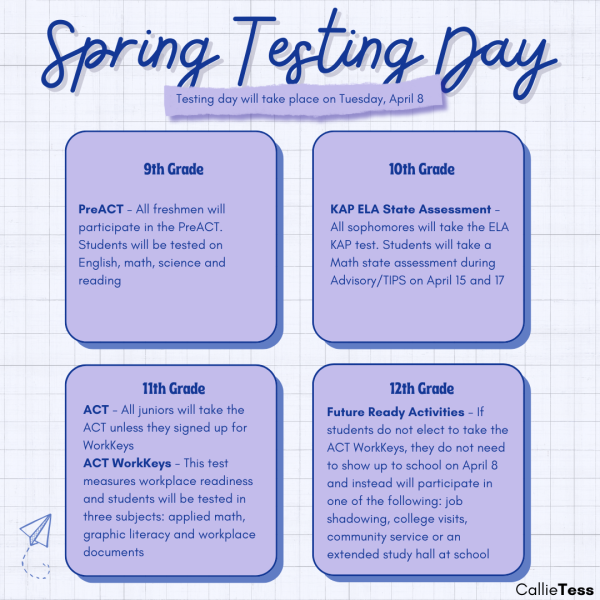Officials discuss how an epidemic would be handled
All the buildings lay empty and in ruins. The pandemonium that followed the outbreak has driven everyone away. Papers rustle quietly across the pavement as the lone survivor walks slowly away into the barren landscape.
Movies about infectious diseases have become common, but they do not portray a realistic event. Health precautions have been put in place on national, state, country and even school levels to help prevent an epidemic.
The school’s first line of defense is general cleanliness of the building. Every night, a crew of 12 wipes down all of the touch surfaces, or anything that may have come in contact with a hand, in the school.
Students also have a responsibility to help prevent the spread of an illness. Many viruses are contracted through the respiratory system and through the eyes. Nurse Mitzi Edwards emphasizes that even though things may be sanitized, the most effective defense against an illness is for a person to wash his or her hands often. Using a tissue once and throwing it away or not sharing food can help, but sometimes an illness is inevitable. In that case, staying home when ill will have the most benefit.
“If you don’t feel well and you are running a fever, don’t come to school,” principal Scott Roberts said. “As much as I want every kid at school every day to learn, if you have a fever and it’s cold and flu season, frankly, it’s better for you to stay home.”
Staying home minimizes exposure for other students. Because so many people come in contact with each other, someone who is sick can spread germs very quickly.
“If you do these things, it will slow [the virus] down,” head custodian Michael Brown said. ”It’s not going to stop it all, but it will help.”
If a student is home sick, the school keeps records to observe if many students have common symptoms, which will indicate a similar virus or different symptoms. However, there are some difficulties in getting the information.
“It would be best if the parents would call in and let me know what symptoms they have and the reason why the student is out,” Edwards said. “Otherwise, I have to call and see who all is absent and why. If the parents could inform me, then that could give me a better picture if there are several different viruses and infections going on or if they all are very similar and might all be symptoms of the same virus.”
The attendance information is then forwarded to the Johnson County Health Department. The health department decides all health-related steps a school must follow.
There, the data is monitored for increases in absences that are greater than five percent or an absence level of ten percent or more. Based on the reported symptoms, the Health Department will then dictate further measures to be put in place to combat the illness.
One of the most common techniques that may be put in place by the health department is the implementation of vaccination clinics. The health department will receive and supply the vaccinations and then supervise the clinics that disperse the vaccines to people. During the H1N1 outbreak a few years ago, the health department and district responded in this way.
“It was a pandemic: [there were] cases all over the world, so it was a matter of time until we knew we had a case. We did surveillance, and tried to do non-pharmaceutical measures like hand washing,” Johnson County Health Department Disease Containment Division director Nancy Tausz said. “After the disease spread, the clinics were set up.”
If an outbreak continues after attempts at vaccinations, or if there is not an available vaccine, another choice mandated by the health department and the district is to close schools.
“We may tell everyone to stay home,” Tausz said. “That’s all we can do. We want to separate all of the sick people from the well people — we want to isolate a case. It would have to be pretty serious to close a school. It really depends [on the illness] or if there are not enough teachers to teach.”
The health department also has specific plans set in place in case of outbreaks of diseases that it is federally required to report.
One of those such illnesses is Ebola.
According to Edwards, if a person comes into her office and has a temperature of over 100.4 degrees, she must ask the patient if he or she has traveled within the last 21 days. If that person replies yes, he or she is quarantined in a room until someone from the hospital arrives.
The policies are being revised as new information concerning the illness is published.
“The risk of Ebola is so low,” Tausz said. “It is understandable, it is frightening to people, [but the health department watches diseases closely], just like every they do every single day. All of the hospitals are aware and ready [but] it is just another disease. The important thing to know is that there is a lot of surveillance through all of the public health system.”
The district and the health department keep a very careful watch over the schools to minimize the chance of an outbreak.
“I’m pretty confident in [the district’s method],” Roberts said. “There are those worst-case-scenarios, but I try not to get too worried. That’s good stuff for the movies, but not stuff that’s necessarily out there.”

Lillie Hoffart is a senior and has been on staff since her freshman year. She enjoys writing and designing for the paper and is the managing editor....












